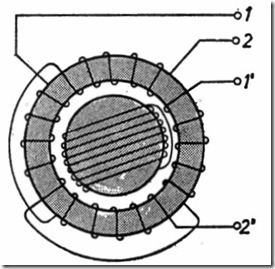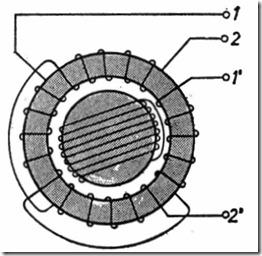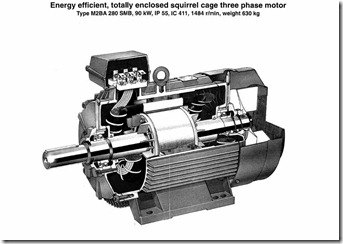1.1. ELECTRIC ENERGY AND INDUCTION MOTORS
The level of prosperity of a community is related to its capability to produce goods and services. But producing goods and services is strongly related to the use of energy in an intelligent way.
Motion and temperature (heat) control are paramount in energy usage. Energy comes into use in a few forms such as thermal, mechanical and electrical.
Electrical energy, measured in kWh, represents more than 30% of all used energy and it is on the rise. Part of electrical energy is used directly to produce heat or light (in electrolysis, metallurgical arch furnaces, industrial space heating, lighting, etc.).
The larger part of electrical energy is converted into mechanical energy in electric motors. Among electric motors, induction motors are most used both for home appliances and in various industries [1-11].
This is so because they have been traditionally fed directly from the threephase a.c. electric power grid through electromagnetic power switches with adequate protection. It is so convenient.
Small power induction motors, in most home appliances, are fed from the local single phase a.c. power grids. Induction motors are rugged and have moderate costs, explaining their popularity.
In developed countries today there are more than 3 kW of electric motors per person, today and most of it is from induction motors.
While most induction motors are still fed from three-phase or single-phase power grids, some are supplied through frequency changers (or power electronics converters) to provide variable speed.
In developed countries, 10% of all induction motor power is converted in variable speed drives applications. The annual growth rate of variable speed drives has been 9% in the last decade while the electric motor markets showed an average annual growth rate of 4% in the same time.
Variable speed drives with induction motors are used in transportation, pumps, compressors, ventilators, machine tools, robotics, hybrid or electric vehicles, washing machines, etc.
The forecast is that, in the next decade, up to 50% of all electric motors will be fed through power electronics with induction motors covering 60 to 70% of these new markets.
The ratings of induction motors vary from a few tens of watts to 33120 kW (45000 HP). The distribution of ratings in variable speed drives is shown in Table 1.1. [1]
Table 1.1. Variable speed a.c. drives ratings
|
Power (kW) |
1 – 4 |
5 – 40 |
40 – 200 |
200 – 600 |
>600 |
|
Percentage |
21% |
26% |
26% |
16% |
11% |
Intelligent use of energy means higher productivity with lower active energy and lower losses at moderate costs. Reducing losses leads to lower environmental impact where the motor works and lower thermal and chemical impact at the electric power plant that produces the required electrical energy. Variable speed through variable frequency is paramount in achieving such goals. As a side effect, the use of variable speed drives leads to current harmonics pollution in the power grid and to electromagnetic interference (EMI) with the environment. So power quality and EMI have become new constraints on electric induction motor drives.
Digital control is now standard in variable speed drives while autonomous intelligent drives to be controlled and repaired via Internet are on the horizon. And new application opportunities abound: from digital appliances to hybrid and electric vehicles and more electric aircraft.
So much in the future, let us now go back to the first two invented induction motors.
1.2. A HISTORICAL TOUCH
Faraday discovered the electromagnetic induction law around 1831 and Maxwell formulated the laws of electricity (or Maxwell’s equations) around 1860. The knowledge was ripe for the invention of the induction machine which has two fathers: Galileo Ferraris (1885) and Nicola Tesla (1886). Their induction machines are shown in Figure 1.1 and Figure 1.2.
 Figure 1.1 Ferrari’s induction motor (1885)
Figure 1.1 Ferrari’s induction motor (1885)
Figure 1.2 Tesla’s induction motor (1886)
Both motors have been supplied from a two-phase a.c. power source and thus contained two phase concentrated coil windings 1-1’ and 2-2’ on the ferromagnetic stator core.
In Ferrari’s patent the rotor was made of a copper cylinder, while in the Tesla’s patent the rotor was made of a ferromagnetic cylinder provided with a short-circuited winding.
Though the contemporary induction motors have more elaborated topologies (Figure 1.3) and their performance is much better, the principle has remained basically the same.
That is, a multiphase a.c. stator winding produces a traveling field which induces voltages that produce currents in the short-circuited (or closed) windings of the rotor. The interaction between the stator produced field and the rotor induced currents produces torque and thus operates the induction motor. As the torque at zero rotor speed is nonzero, the induction motor is self-starting.
The three-phase a.c. power grid capable of delivering energy at a distance to induction motors and other consumers has been put forward by DolivoDobrovolsky around 1880.
In 1889, Dolivo-Dobrovolsky invented the induction motor with the wound rotor and subsequently the cage rotor in a topology very similar to that used today. He also invented the double-cage rotor.
Thus, around 1900 the induction motor was ready for wide industrial use. No wonder that before 1910, in Europe, locomotives provided with induction motor propulsion, were capable of delivering 200 km/h.
However, at least for transportation, the d.c. motor took over all markets until around 1985 when the IGBT PWM inverter was provided for efficient frequency changers. This promoted the induction motor spectacular comeback in variable speed drives with applications in all industries.
Figure 1.3 A state-of-the-art three-phase induction motor (source ABB motors)
Mainly due to power electronics and digital control, the induction motor may add to its old nickname of “the workhorse of industry” the label of “the racehorse of high-tech”.
A more complete list of events that marked the induction motor history follows.
• Better and better analytical models for steady state and design purposes
• The orthogonal (circuit) and space phasor models for transients
• Better and better magnetic and insulation materials and cooling systems
• Design optimization deterministic and stochastic methods
• IGBT PWM frequency changers with low losses and high power density (kW/m3) for moderate costs
• Finite element methods (FEMs) for field distribution analysis and coupled circuit-FEM models for comprehensive
• Developments of induction motors for super-high speeds and high powers
• A parallel history of linear induction motors with applications in linear motion control has unfolded
• New and better methods of manufacturing and testing for induction machines
• Integral induction motors: induction motors with the PWM converter integrated into one piece

